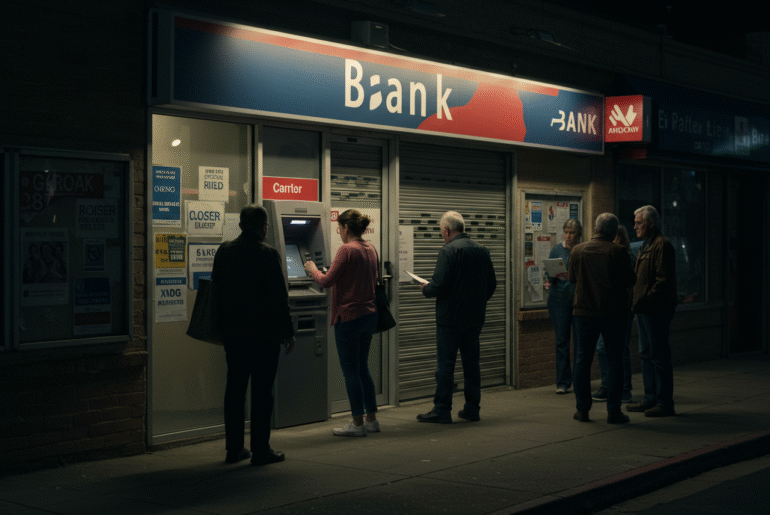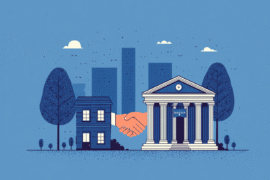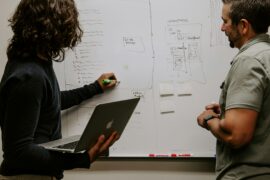This article may contain references to products or services from one or more of our advertisers or partners. We may receive compensation when you click on links to those products or services. Nonetheless, our opinions are our own.
The information presented in this article is accurate to the best of our knowledge at the time of publication. However, information is subject to change, and no guarantees are made about the continued accuracy or completeness of this content after its publication date.
- Bank Closures and Your Personal Finances
- How Bank Closures Are Shaping Daily Banking and Access
- Changes in Banking Accessibility for Customers
- Adapting Banking Habits to Fewer Branches
- Managing Finances with Fewer Local Options
- Alternative Banking Options for Greater Flexibility
- Planning for Changes in Your Financial Future
- Community Effects of Local Bank Closures
- How Bank Branch Closures Affect Your Finances in the End
- Frequently Asked Questions
- Recommended Reads
Bank Closures and Your Personal Finances
The news that a big bank is closing 20% of its locations might make you feel worried about your money and how safe it is. It’s important to see how these changes can spread into the way you do your banking and take care of your money. If the branch you use the most is now closed, you might not be able to go in for in-person services like you did before. This can make it harder to talk in person about your account needs. Here are a few things to think about:
| Financial Aspect | Potential Impact |
|---|---|
| Banking Fees | Increased due to fewer location options |
| ATM Access | There is limited access. This can lead to extra charges. |
| Customer Service | Possible delays and longer wait times |
It’s important to know about these changes and look again at what you need from your bank. This is a good time to see if there are other banks or credit unions that can give you better service or lower fees. Doing this may help you keep a close watch on your money as things change. Every change in banking can show new ways to keep your money safe and help your savings stay strong.
How Bank Closures Are Shaping Daily Banking and Access
According to Newsweek, dated April 2025, over 300 U.S. bank branches were set to close in just the first three months of the year, based on data from the Office of the Comptroller of the Currency. S&P Global, dated May 2025, reported that 148 of those closures already happened, with U.S. Bank and Wells Fargo leading the list. This is a big jump from the end of last year. The Federal Reserve Bank of Philadelphia also warned that many rural and low-income areas are now “banking deserts” because they’ve lost their only local branches. This makes it harder for people to get cash, in-person help, or financial advice. While online banking is growing, not everyone has internet or knows how to use banking apps, especially older adults or families without access to digital tools. That’s why closing branches can create real problems for some communities.
Changes in Banking Accessibility for Customers
Many big banks are closing a lot of their branches now. Because of this, it is important to look at how these changes can affect your banking. With fewer places to go in person, you might need to use different ways to get the services you need from your bank. Here are some main things to think about:
- Digital Services Growth: With the number of branches going down, banks are putting a lot of money into online and mobile banking. This is to make your banking better with things like mobile deposits, quick transfers, and customer help all day and night.
- Accessibility Variations: People who live in cities may use digital banking more easily, but those in small towns or outside city areas might feel it more when there are fewer branches. You need to know your choices.
- Customer Support Changes: As we count on tech more, make sure your bank gives good online help. See if your bank’s site has helpful FAQs, chatbots, or someone you can contact right away.
| Consideration | Possible Impact |
|---|---|
| Branch Closure | Reduced in-person transactions |
| Digital Banking Tools | It is easier to use, but you may need some time to learn how it works. |
| Customer Service Shift | Possible delays in response or service |
Adapting Banking Habits to Fewer Branches
As major banks close their branches, you may need to change how you do your banking. It is a good idea to start using digital ways to handle your money. Here are some steps you can take:
- Use Mobile Banking Apps: Most banks now have strong mobile apps. You can deposit checks, pay bills, and send money to others with these. Get to know these features so banking is easy and quick for you.
- Set Up Online Alerts: To keep track of your money, turn on alerts for things like when your bank activity changes, when you have low money, or when your bills are due. This helps you stay aware, so you do not spend too much or forget to pay something.
- Check Out Online Money Tools: You might want to use online tools to help with your budget, saving plans, or even following how your money grows. Use these from your computer or phone. They can help you handle your money in a good, simple way wherever you are.
| Change | Adaptation Strategy |
|---|---|
| Reduced Location Access | Try to use online banking for things you would usually do at the bank. |
| Limited In-Person Support | Get in touch with customer service by chat or email for quick help. |
| Shift to Digital Transactions | Get used to using online payment tools like e-wallets and money-moving services. |
Voted "Best Overall Budgeting App" by Forbes and WSJ
Monarch Money helps you budget, track spending, set goals, and plan your financial future—all in one app.
Get 50% OFF your first year with code MONARCHVIP
Managing Finances with Fewer Local Options
With the recent news that a big bank will close 20% of its locations, you may see fewer local places to handle your money. This change can bring some new problems. But it also gives you chances to try new ways to take care of your money. Begin looking at digital banking. Mobile apps and online services may give you the same things that you get from banks, and sometimes even more. Think about these choices:
- Online Banks: These places are on the internet and often have lower fees and better rates on savings. This is because they do not have the same high costs as regular banks.
- Mobile Payment Apps: Apps like Venmo or Cash App help you pay or get money from others. They make the way you buy things and send money simple, and you do not need to go to a bank.
- Budgeting Tools: Use apps like Mint or YNAB (You Need A Budget) so you can watch your spending and make a budget fit for you.
| Financial Institution Type | Benefits |
|---|---|
| Online Banks | Higher interest rates, no minimums, easy way to get your money |
| Credit Unions | Member-focused with lower fees and a personal touch |
| Fintech Companies | Creative tools, easy-to-use designs, and special services |
Alternative Banking Options for Greater Flexibility
Traditional banks are changing in many ways. Now is the time to look at other choices besides local bank branches. Many big banks are closing some of their locations. Because of this, you might be asking yourself, “What else is there?” Other types of banking can give you more freedom and new tools. They can also cost less. Think about these choices that can fit into your money life with ease:
- Online Banks: These only work online. They give you better interest rates and lower fees. This is because they do not have the cost of running real branches.
- Credit Unions: These focus on helping local people. They usually give better rates and more useful services than most regular banks. You can feel like you belong when you are part of one.
- Fintech Apps: These are easy-to-use mobile apps for banking, budgeting, and investing. They often come with special tools to help you manage your money better.
| Banking Solution | Pros | Cons |
|---|---|---|
| Online Banks | Higher interest rates, lower fees | No physical branches for in-person service |
| Credit Unions | Personalized service, community-oriented | Limited ATM networks |
| Fintech Apps | Easy budgeting tools, instant updates | Less regulation and potential security risks |
Planning for Changes in Your Financial Future
As you go through the changing world of banking, it is important to know how these changes may impact your plan for handling money in the next few years. With 20% of bank branches closing, think about how this change can change the way you reach services and take care of your money. You might have to get used to using digital banking, with online services and apps that let you do your transactions right from your phone or computer. This way of using tech can make banking easier and help you keep a close eye on how you spend and save your money.
Review Your Banking Habits
Check how often you use in-person services, mobile apps, or online tools. Make sure your bank supports your current needs and doesn’t charge unnecessary fees.
Explore Online Banking Options
Online banks often offer better interest rates, lower fees, and easy-to-use apps. Compare features to see if switching could save you time and money.
Stay Updated on Bank Changes
Watch for updates about new fees, service limits, or policy changes. Staying informed helps you avoid extra costs and manage your account more effectively.
| Action | Benefits |
|---|---|
| Switch to Online Banking | Convenience and 24/7 access |
| Use Budgeting Apps | Improved financial tracking |
| Set up Auto-Pay | Timely bill payments and lower fees |
Community Effects of Local Bank Closures
Bank branch closures affect more than individual customers; they disrupt entire communities. Small towns and low-income areas often lose vital services like loans, jobs, and in-person financial support. Without nearby branches, vulnerable groups may struggle with basic banking tasks and face limited alternatives.
Unemployment Increases and Changes
Branch closures lead to job losses for tellers, managers, and support staff. This can hurt local economies and reduce upward mobility. Some displaced workers may be offered transfers, but many are left without options.
Increased Cost for Banking Services
With fewer branches, customers rely more on digital or third-party services, which often come with extra fees. Out-of-network ATMs and rising maintenance costs hit low-income users hardest, making everyday banking more expensive.
Digital Barriers for Disabled and Underserved Customers
Not everyone can easily switch to online banking. Disabled users may face inaccessible platforms, while seniors, rural residents, and non-English speakers often lack the tools or skills needed. These gaps leave many excluded from safe, affordable financial services. To support affected communities, solutions like mobile banking education, public internet programs, and expanded credit union access are critical.
How Bank Branch Closures Affect Your Finances in the End
Bank closures can feel like a loss, but they also present opportunities to embrace modern tools that make financial management easier. By evaluating your options, staying informed, and exploring new banking methods, you can adapt with confidence. Whether you transition to online banks, use fintech apps, or rely on credit unions, the goal remains the same: maintaining control over your money. Stay proactive and informed to keep your financial life running smoothly.
Frequently Asked Questions
Why is the bank closing 20% of its locations?
The bank is closing some of its places because more people now use online banking. Many customers do their banking on the internet, so fewer people go to the branches. The bank also wants to make things work better and spend less money. This will help the bank do things in a good and simple way.
How will this impact customers?
Customers might have to spend more time to get to their closest branch. But the bank is putting more effort into making its online banking better. This should help make banking easier for people who like to do their banking on the internet. The bank also wants to make sure that helping customers stays important, even with fewer branches.
What should customers do if their local branch is closing?
Customers can start by getting to know the bank’s online tools and features. These can help people manage their money from home or on the go. The bank will help and guide the customers as they move to other ways of banking. If you have any questions or need help, it is good to contact customer service.
Are there plans for future branch openings?
Right now, the bank is closing locations that do not do well. The bank is watching changes in the market. There may be new openings in places where there is a lot of demand and growth is strong. This is most likely in the areas where the bank can help customers better with new technology.
How can customers provide feedback regarding the closures?
Customers can give their thoughts and feedback by using customer service channels, surveys, or the bank’s official website. The bank wants to hear from its customers. They use this information to know what people need and feel during this time.

Reviewed and edited by Albert Fang.
See a typo or want to suggest an edit/revision to the content? Use the contact us form to provide feedback.
At FangWallet, we value editorial integrity and open collaboration in curating quality content for readers to enjoy. Much appreciated for the assist.
Did you like our article and find it insightful? We encourage sharing the article link with family and friends to benefit as well - better yet, sharing on social media. Thank you for the support! 🍉
Article Title: Bank Closures and Community Impact
https://fangwallet.com/2025/07/02/bank-closures-and-community-impact/The FangWallet Promise
FangWallet is an editorially independent resource - founded on breaking down challenging financial concepts for anyone to understand since 2014. While we adhere to editorial integrity, note that this post may contain references to products from our partners.
The FangWallet promise is always to have your best interest in mind and be transparent and honest about the financial picture.
Become an Insider

Subscribe to get a free daily budget planner printable to help get your money on track!
Make passive money the right way. No spam.
Editorial Disclaimer: The editorial content on this page is not provided by any of the companies mentioned. The opinions expressed here are the author's alone.
The content of this website is for informational purposes only and does not represent investment advice, or an offer or solicitation to buy or sell any security, investment, or product. Investors are encouraged to do their own due diligence, and, if necessary, consult professional advising before making any investment decisions. Investing involves a high degree of risk, and financial losses may occur including the potential loss of principal.
Source Citation References:
+ Inspo
S&P Global Market Intelligence. (2025, May). Pace of US bank branch closures picks up in Q1 2025. S&P Global. Federal Reserve Bank of Philadelphia. (2024, February). U.S. bank branch closures and banking deserts. https://www.philadelphiafed.org Newsweek. (2025, April). Map shows bank closures across US in 2025 so far. Newsweek.












































